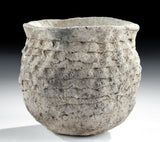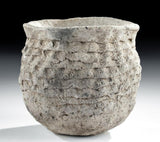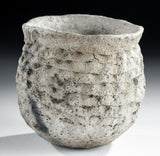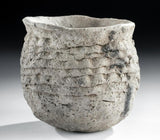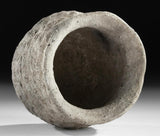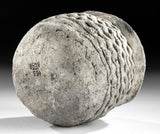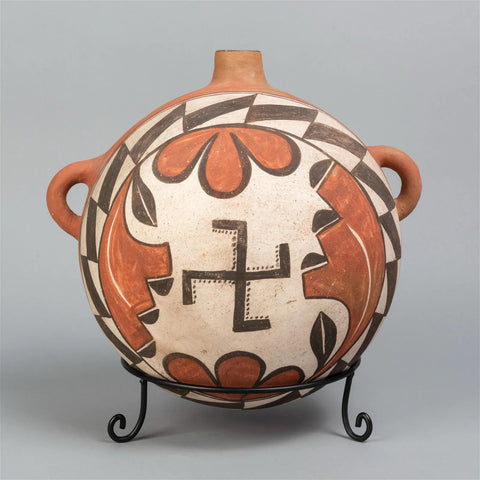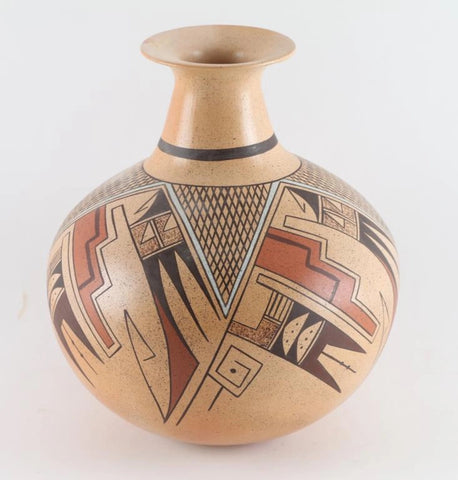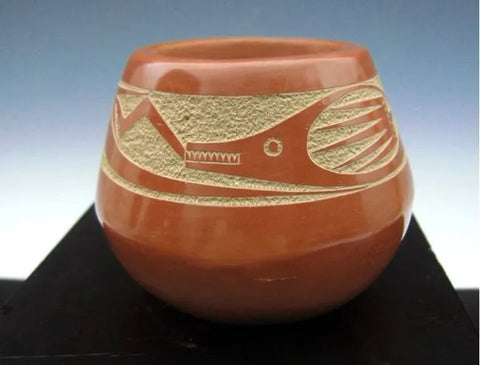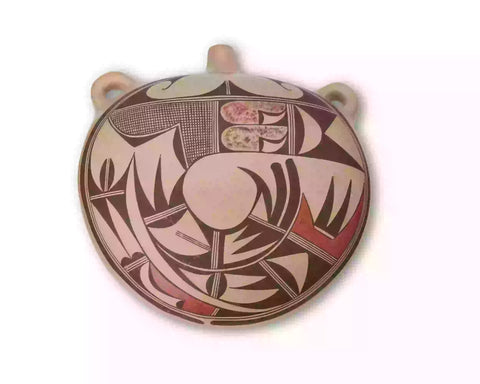
A Mogollon Corrugated Pottery Jar - From the Mesa Verde Museum, Ca 1000 to 1150 CE, #1500
$ 1,250.00
A Mogollon Corrugated Pottery Jar - From the Mesa Verde Museum, Ca 1000 to 1150 CE, #1500
Description: #1500 A Mogollon Corrugated Pottery Jar - From the Mesa Verde Museum, Ca 1000 to 1150 CE. Southwestern USA, Southwestern New Mexico, Southeast Arizona, and Northern Chihuahua region of Mexico, Mogollon culture, ca. 1000 to 1150 CE. A charming miniature hand-built grey pottery olla of a rounded form with a slightly flared rim, its form of the Reserve Indented Corrugated style. This technique requires immense skill. Each coil was carefully indented with the potter's finger at remarkably regular, tight intervals - a step that contributed to the integrity of the form as well. The rounded base suggests that this vessel was made to be set in a sandy floor. The artists responsible for creating pottery vessels like this one were usually women. Many Mogollon women have been found in burials accompanied by pottery making tools.
Dimensions: Size: 3" W x 2.7" H (7.6 cm x 6.9 cm)
Provenance: ex-Joan Shaw collection, bought in 1971; loaned to the Mesa Verde Museum, 1962-1970; ex-Bill Mitchell collection, Cortez, Colorado, USA, from 1958-1962
Condition: Intact, with light surface wear commensurate with age. Nice deposits on surface. Handwritten collection number on underside.
All items legal to buy/sell under U.S. Statute covering cultural patrimony Code 2600, CHAPTER 14, and are guaranteed to be as described or your money back.
Mogollon culture: Mogollon culture, prehistoric North American Indian peoples who, from approximately AD 200–1450, lived in the mostly mountainous region of what are now southeastern Arizona and southwestern New Mexico. Their name derives from the Mogollon Mountains in New Mexico. The culture is presumed to have developed out of the earlier Cochise culture, with additional influences from elsewhere. The first pottery in the Southwest was made by the Mogollon, and it was well made from the beginning, suggesting that the craft may have been imported from Mexico.
The Mogollon culture has been divided into various developmental periods, though consensus is lacking because of incomplete evidence and because of the different rates of development across the immense geographic area these people inhabited. In speaking about Mogollon culture generally, however, scholars frequently make reference to five developmental periods: Mogollon 1 and 2, approximately AD 200–650; Mogollon 3, 650–850; Mogollon 4, 850–1000; and Mogollon 5, 1000–1450, which includes the Classic Mimbres phase, 1050–1200.
During the Mogollon 1 period, the people lived in small villages of circular wattle-and-daub pit houses, the floors of which were from 10 to 40 inches (25 to 100 cm) below ground level; entrance was usually through tunnels. They obtained food principally by foraging wild seeds, roots, and nuts, though agriculture was apparently incipient at this time. It is thought that hunting in this period focused on small prey, such as rabbits and lizards, that could be caught in nets or snares. Pottery, as already noted, was being made and differed in type from that which would be developed by neighbouring groups. The same basic pattern continued in the Mogollon 2, except that more varieties of pottery appeared and corn (maize) cultivation and the hunting of larger game such as deer assumed predominance.
This pattern persisted into the Mogollon 3 period; the major changes marking this period include additional pottery types and the transition from round, lightly built pit houses to more heavily built pit homes. The people began to build separate ceremonial pit structures, or kivas. The appearance of these structures suggests the influence of the Ancestral Pueblo (Anasazi), whose homeland was in northern New Mexico.
In the Mogollon 4 period the means of subsistence continued as before. Pit homes were increasingly constructed of stone masonry, again suggesting Ancestral Pueblo influence. Pottery types became more various and sophisticated.
In the Mogollon 5 period, and especially during the Mimbres phase, profound changes occurred: pit houses were replaced by adobe and masonry apartment houses that were built at ground level and rose one to three stories high. These pueblo villages sometimes contained 40 to 50 rooms arranged around a plaza. Such traits, together with others, were probably introduced to the area by Ancestral Pueblo. There is evidence from this period that Ancestral Pueblo and Mogollon individuals lived peacefully in the same villages.
The Mogollon culture ended for unknown reasons in the 15th century. The people abandoned their villages, perhaps dispersing over the landscape or joining other village groups. (WRITTEN BY: The Editors of Encyclopaedia Britannica. This article was most recently revised and updated by Chelsey Parrott-Sheffer, Research Editor)
Description: #1500 A Mogollon Corrugated Pottery Jar - From the Mesa Verde Museum, Ca 1000 to 1150 CE. Southwestern USA, Southwestern New Mexico, Southeast Arizona, and Northern Chihuahua region of Mexico, Mogollon culture, ca. 1000 to 1150 CE. A charming miniature hand-built grey pottery olla of a rounded form with a slightly flared rim, its form of the Reserve Indented Corrugated style. This technique requires immense skill. Each coil was carefully indented with the potter's finger at remarkably regular, tight intervals - a step that contributed to the integrity of the form as well. The rounded base suggests that this vessel was made to be set in a sandy floor. The artists responsible for creating pottery vessels like this one were usually women. Many Mogollon women have been found in burials accompanied by pottery making tools.
Dimensions: Size: 3" W x 2.7" H (7.6 cm x 6.9 cm)
Provenance: ex-Joan Shaw collection, bought in 1971; loaned to the Mesa Verde Museum, 1962-1970; ex-Bill Mitchell collection, Cortez, Colorado, USA, from 1958-1962
Condition: Intact, with light surface wear commensurate with age. Nice deposits on surface. Handwritten collection number on underside.
All items legal to buy/sell under U.S. Statute covering cultural patrimony Code 2600, CHAPTER 14, and are guaranteed to be as described or your money back.
Mogollon culture: Mogollon culture, prehistoric North American Indian peoples who, from approximately AD 200–1450, lived in the mostly mountainous region of what are now southeastern Arizona and southwestern New Mexico. Their name derives from the Mogollon Mountains in New Mexico. The culture is presumed to have developed out of the earlier Cochise culture, with additional influences from elsewhere. The first pottery in the Southwest was made by the Mogollon, and it was well made from the beginning, suggesting that the craft may have been imported from Mexico.
The Mogollon culture has been divided into various developmental periods, though consensus is lacking because of incomplete evidence and because of the different rates of development across the immense geographic area these people inhabited. In speaking about Mogollon culture generally, however, scholars frequently make reference to five developmental periods: Mogollon 1 and 2, approximately AD 200–650; Mogollon 3, 650–850; Mogollon 4, 850–1000; and Mogollon 5, 1000–1450, which includes the Classic Mimbres phase, 1050–1200.
During the Mogollon 1 period, the people lived in small villages of circular wattle-and-daub pit houses, the floors of which were from 10 to 40 inches (25 to 100 cm) below ground level; entrance was usually through tunnels. They obtained food principally by foraging wild seeds, roots, and nuts, though agriculture was apparently incipient at this time. It is thought that hunting in this period focused on small prey, such as rabbits and lizards, that could be caught in nets or snares. Pottery, as already noted, was being made and differed in type from that which would be developed by neighbouring groups. The same basic pattern continued in the Mogollon 2, except that more varieties of pottery appeared and corn (maize) cultivation and the hunting of larger game such as deer assumed predominance.
This pattern persisted into the Mogollon 3 period; the major changes marking this period include additional pottery types and the transition from round, lightly built pit houses to more heavily built pit homes. The people began to build separate ceremonial pit structures, or kivas. The appearance of these structures suggests the influence of the Ancestral Pueblo (Anasazi), whose homeland was in northern New Mexico.
In the Mogollon 4 period the means of subsistence continued as before. Pit homes were increasingly constructed of stone masonry, again suggesting Ancestral Pueblo influence. Pottery types became more various and sophisticated.
In the Mogollon 5 period, and especially during the Mimbres phase, profound changes occurred: pit houses were replaced by adobe and masonry apartment houses that were built at ground level and rose one to three stories high. These pueblo villages sometimes contained 40 to 50 rooms arranged around a plaza. Such traits, together with others, were probably introduced to the area by Ancestral Pueblo. There is evidence from this period that Ancestral Pueblo and Mogollon individuals lived peacefully in the same villages.
The Mogollon culture ended for unknown reasons in the 15th century. The people abandoned their villages, perhaps dispersing over the landscape or joining other village groups. (WRITTEN BY: The Editors of Encyclopaedia Britannica. This article was most recently revised and updated by Chelsey Parrott-Sheffer, Research Editor)
Related Products
Sold out

